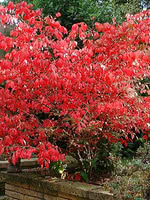Mon-Fri 9am - 5pm Mountain time
Burning Bush vs Bilberry
Vaccinium myrtillus
Euonymus alatus
CUSTOM GROW
Bilberry is a native perennial shrub valued for its small, blue-black berries that ripen in mid to late summer. The berries resemble blueberries but have a richer, more tart, and intense flavor. They have long been used for fresh eating, baking, and preserves, while also providing food for birds and mammals. In spring, its delicate pinkish flowers attract bees and other pollinators.
Growing low to the ground, Bilberry forms spreading colonies that create dense understory cover. This growth habit provides food and shelter for wildlife, and its foliage adds seasonal interest by turning red to purple in autumn. With its adaptability and ecological benefits, Bilberry is well-suited for naturalization, ecological restoration, and pollinator gardens.
Burning Bush is a unique shrub whose leaves turn firey red in the fall. You can plant it in rows to make a hedge or on its own. Burning Bush requires little maintenance and thrives in just about any kind of soil, which makes it a good choice for inexperienced growers. Plant it in full sun to get its best fall color.
Select Cultivar: Dwarf Burning Bush is a smaller variety of Burning Bush. This shrub has a compact form and only reaches 4-5ft tall and 4-5ft wide.
Note: Burning Bush is considered an invasive species in eastern North America. Please plant the right tree in the right place.
Bilberry Quick Facts
Burning Bush Quick Facts
Toxicity: leaves may be unsafe in high doses

